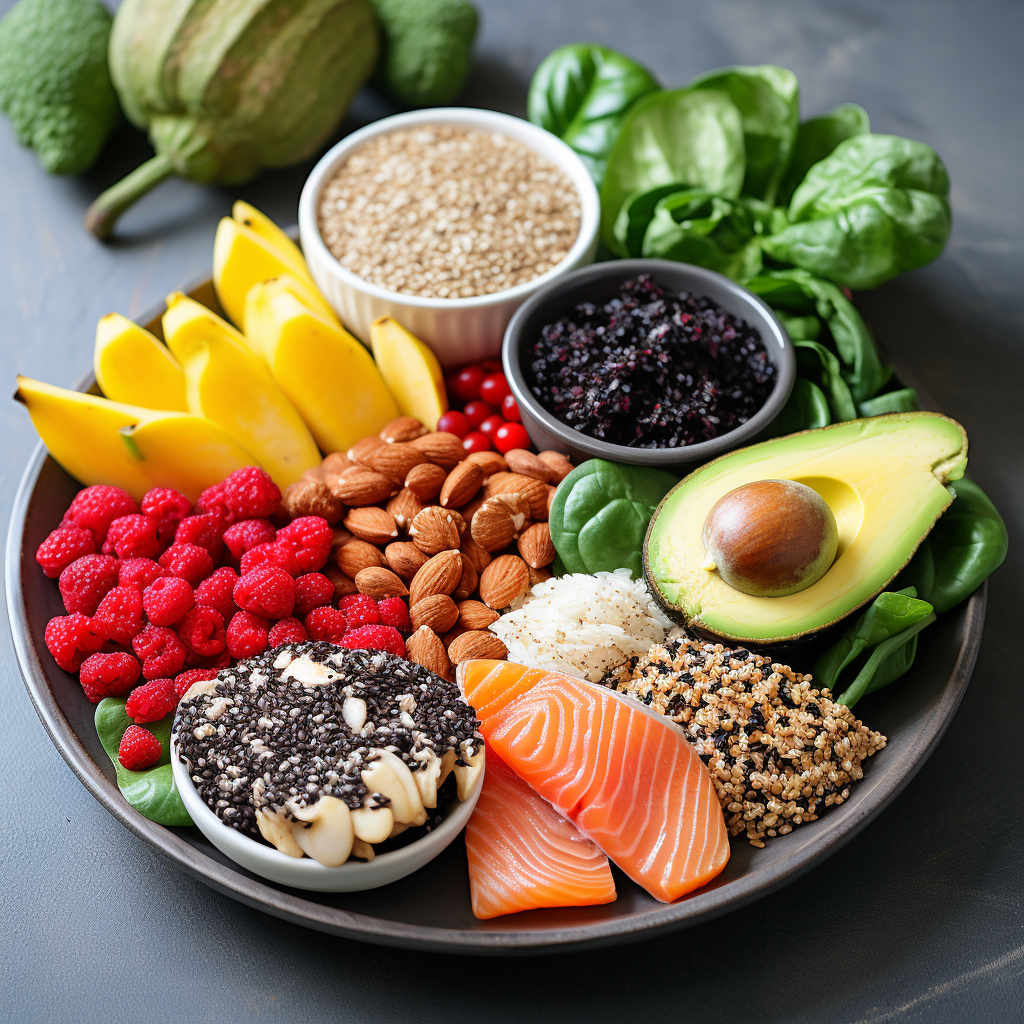
by Elizabeth Redd | Feb 19, 2024 | Fitness, Health, Nutrition
Understanding the anatomy and function of your biceps is essential for getting the most out of your workouts. The biceps brachii, commonly known as the biceps, is a two-headed muscle located on the upper arm between the shoulder and the elbow. This muscle is responsible for various movements, including the flexion of the elbow and the supination of the forearm, which means turning the palm up or forward. This dual functionality makes the biceps crucial not only for lifting but also for the rotational movements of the arm.
Furthermore, the biceps muscle plays a significant role in the aesthetics of the upper body, contributing to the rounded appearance of the upper arm when developed. Thus, when considering what to workout with biceps, it’s vital to include exercises that target both heads of the muscle for balanced growth and strength. For instance, hammer curls emphasize the brachialis, a muscle that lies beneath the biceps, enhancing the overall thickness of the arm.
By incorporating a variety of exercises into your regimen, you can ensure that all aspects of the biceps muscle are engaged. This approach leads to not only more functional strength but also a more defined and aesthetically pleasing appearance. And remember, proper form and technique are just as important as the exercises themselves to prevent injury and maximize gains.
Ready to kickstart your wellness journey? Sign up for our content at Health And Healing AI to receive exclusive tips and updates. Take the first step towards a healthier, happier you! Join Our Community Today!
Essential Bicep Exercises for Strength and Mass
To build both strength and mass in the biceps, it’s important to focus on exercises that provide enough stimulus for muscle growth. One fundamental exercise is the standing barbell curl, which targets the entire biceps muscle group and allows for heavy lifting, stimulating hypertrophy. Another essential movement is the dumbbell curl, performed either alternating or simultaneously, which helps in developing unilateral strength and balances out any asymmetries.
In addition to these, incorporating concentration curls can be particularly effective for peak contraction, as they isolate the biceps and prevent other muscles from assisting in the lift. For those looking to enhance the ‘peak’ of their biceps, incline dumbbell curls are excellent as they stretch the long head of the biceps, working it through a full range of motion.
To optimize bicep development, it is also advisable to include exercises that target the brachialis and brachioradialis, such as hammer curls and reverse curls. These movements complement the bicep curls and contribute to the overall size of the arms. Lastly, incorporating cable curls can offer consistent tension throughout the exercise, which is beneficial for muscle growth.
When planning what to workout with biceps, variety and progressive overload are key. Gradually increasing the weight and mixing these exercises into your routine will lead to significant improvements in both strength and mass over time. It’s crucial to pay attention to form and maintain control throughout each movement to prevent injury and ensure the biceps are fully engaged during each exercise.
Incorporating Compound Movements with Bicep Training

While isolation exercises are crucial for bicep development, incorporating compound movements into your training regimen can significantly enhance overall arm strength and size. Compound exercises engage multiple muscle groups and joints, leading to greater hormonal responses and potential for muscle growth.
One of the most effective compound exercises for biceps is the pull-up. When performed with a supinated grip (palms facing you), pull-ups not only work the back muscles but also place a considerable amount of stress on the biceps, encouraging strength and hypertrophy. Similarly, chin-ups are a close relative to pull-ups with a greater emphasis on the biceps, making them another excellent choice for compound bicep training.
Another key compound movement is the barbell row. While primarily targeting the upper back, maintaining a proper form during the exercise also involves the biceps which act as secondary muscles, aiding in the pulling motion. Additionally, the deadlift, one of the most comprehensive compound exercises, indirectly works the biceps through isometric tension as they help in gripping and holding the bar.
It’s important to remember that when integrating compound movements with bicep-focused training, balance is essential. These exercises should complement your bicep workouts, not overshadow them. By combining compound and isolation exercises, you’re ensuring a well-rounded approach to arm development that can yield impressive results in both strength and aesthetic.
Understanding what to workout with biceps can make a significant difference in your training outcomes. With the right mix of compound and isolation exercises, you can achieve a balanced and powerful upper body physique.
Maximizing Your Bicep Growth with Proper Technique

Maximizing bicep growth requires more than just lifting weights; proper technique is paramount. To ensure you are on the path to achieving the best possible results, focus on the quality of each movement rather than the quantity of weight used. A key aspect of proper technique involves mind-muscle connection. This practice entails concentrating on the bicep muscle during each curl to enhance muscle activation and growth.
Start by selecting a weight that allows you to perform exercises with control and full range of motion. During a bicep curl, for instance, ensure that your elbows are close to your torso and that you are not using momentum to lift the weights. The movement should be slow and deliberate, with a squeeze at the top of the contraction and a controlled descent to fully engage the muscle fibers.
Another aspect of technique is the wrist position. Keeping your wrists straight and firm throughout the exercise can prevent strain and maintain the focus on the biceps. Additionally, varying your grip width and style – such as using a hammer grip – can target different parts of the biceps and contribute to overall arm development.
Lastly, breathing correctly is often overlooked but is essential for maximizing bicep growth. Inhale as you lower the weight and exhale during the muscle contraction. This not only helps maintain rhythm but also ensures adequate oxygen supply to the muscles, which is crucial for sustained muscle performance and growth.
By paying close attention to these technical elements, you will be able to work out with biceps more effectively and see a noticeable difference in muscle growth and definition. Remember, it’s not just about lifting heavy; it’s about lifting right.
Balancing Bicep Workouts with Overall Fitness Goals

When focusing on what to workout with biceps, it is crucial to balance these exercises with your overall fitness goals. Bicep workouts should be part of a comprehensive training routine that promotes muscle harmony and prevents imbalances. To achieve this, it’s essential to incorporate exercises that target the opposing muscle group, the triceps, as well as compound movements that engage multiple muscle groups.
For a harmonious upper body development, integrate push-pull exercises into your regimen. This ensures that you’re not overworking the biceps and neglecting other important muscles that contribute to arm strength and functionality. Exercises such as push-ups, bench presses, and rows work a range of muscles and can enhance overall upper body aesthetics and performance.
Moreover, it’s important to consider how bicep workouts fit into your total body fitness plan. If your goal is to increase muscle mass, higher volume and intensity for bicep exercises can be beneficial. However, if you’re aiming for a lean physique or weight loss, your bicep workouts should be complemented with cardiovascular exercise and a caloric deficit in your diet.
Lastly, don’t forget the importance of rest and recovery. Muscles need time to repair and grow, and the biceps are no exception. Ensure you’re allowing enough time between bicep workouts for recovery, and consider incorporating stretching and foam rolling to aid in muscle recovery and flexibility.
In conclusion, balancing your bicep workouts with your overall fitness goals means considering a variety of exercises, paying attention to the rest of your body, and aligning your routines with your desired outcomes. By doing so, you’ll not only achieve better bicep development but also enhance your overall health and fitness levels.
Nutrition and Recovery Tips for Bicep Development

Ready to kickstart your wellness journey? Nutrition and recovery play pivotal roles in achieving well-defined biceps and should not be overlooked. The adage ‘you are what you eat’ holds particularly true when it comes to muscle development. Consuming a diet rich in lean proteins, complex carbohydrates, and healthy fats provides the essential building blocks for muscle repair and growth. Foods such as chicken breast, fish, legumes, whole grains, and nuts should be staples in your diet when focusing on bicep development.
Hydration is another key aspect of nutrition that affects muscle performance and recovery. Drinking ample water throughout the day assists in transporting nutrients to your muscles and removing waste products, which is crucial after intense workouts. Aim for at least 8 glasses of water a day, and more if you are engaging in heavy training.
Recovery techniques should also be incorporated into your routine to aid in bicep development. Adequate sleep, typically 7-9 hours per night, is necessary for muscle repair and growth. Additionally, consider implementing active recovery days that include light activity, such as walking or yoga, to promote blood flow and reduce muscle soreness.
Supplementation can also be advantageous. Supplements like branched-chain amino acids (BCAAs), whey protein, and creatine can support muscle recovery and growth when used in conjunction with a balanced diet. However, always consult with a healthcare professional before starting any supplement regimen.
By integrating these nutrition and recovery strategies, you’ll be better equipped to achieve your bicep building goals. Join Our Community Today. and receive exclusive tips and updates to take the first step towards a healthier, happier you!

by Elizabeth Redd | Feb 17, 2024 | Health, Holistic Living, Mindfulness
Welcome to a year of rejuvenation and self-improvement. As we step into 2023, let us mark our calendars for the enriching experience that health and wellness fairs offer. These events are not just about discovering the latest in fitness trends or nutrition tips; they are a holistic celebration of well-being, where like-minded individuals come together to inspire and learn from each other.
Attending health and wellness fairs near me in 2023 can be a transformative experience. These fairs often feature a variety of activities, including interactive workshops, health screenings, and mindfulness sessions, designed to empower you to take charge of your health and happiness. You’ll have the opportunity to meet experts in various fields, from holistic health practitioners to fitness gurus, and explore a multitude of resources that can aid in your wellness journey.
Ready to kickstart your wellness journey? Sign up for our content to receive exclusive tips and updates. Take the first step towards a healthier, happier you! Join Our Community Today!
Whether you’re looking to adopt a new fitness routine, deepen your understanding of nutritional science, or find spiritual balance, these fairs are a gateway to enhanced well-being. The connections made here can often lead to lifelong friendships and a supportive community eager to share their journey towards optimal health. So, don’t let this chance slip by; explore the health and wellness fairs near you in 2023 and embrace the path to vibrant health and happiness.
Exploring the Benefits of Attending Local Health Fairs

Local health fairs have become a beacon for those seeking to enhance their wellness in a community setting. By exploring the myriad of benefits these fairs provide, individuals can find not only motivation but also the practical tools needed to implement lasting health changes. One of the primary advantages of attending is the access to a wealth of information and services in one convenient location. This can range from free or low-cost health screenings that provide immediate feedback on one’s health status to educational seminars that demystify complex health concepts.
Moreover, health fairs often serve as a catalyst for behavioral change, offering a unique environment that encourages participants to engage with health professionals and ask questions they might not otherwise have the opportunity to discuss. The informal yet informative setting fosters a sense of comfort and openness, leading to more productive conversations about personal health concerns.
Another significant benefit is the exposure to new health and wellness products and services. Exhibitors typically showcase the latest innovations, from cutting-edge fitness equipment to nutritional supplements, giving attendees the chance to explore and sample products firsthand. This hands-on experience is invaluable for those looking to make informed decisions about the tools they incorporate into their health regimen.
Lastly, but certainly not least, is the community aspect. Attending a health fair can connect you with others who share your health goals, creating a supportive network that can lead to increased accountability and sustained motivation. This social component is often the missing link for many in their wellness journey, providing both inspiration and companionship as they embark on a path to better health.
How to Find Upcoming Health and Wellness Fairs Nearby

Locating upcoming health and wellness fairs in your vicinity can be a straightforward process if you know where to look. Begin by harnessing the power of the internet; search engines are an invaluable resource. Simply typing “health and wellness fairs near me 2023” into your search bar can yield a comprehensive list of upcoming events. Additionally, social media platforms often have event pages or community groups dedicated to health and wellness where fairs and related gatherings are advertised.
Another effective strategy is to tap into local resources. Hospitals, community centers, and wellness clinics frequently sponsor or host health fairs and usually have information available on their websites or bulletin boards. Checking with these institutions can provide insights into events that may not be widely advertised online.
Don’t overlook the value of networking. Health professionals, fitness trainers, and wellness coaches often have the inside scoop on local events and can point you in the right direction. Engaging with these individuals can also lead to personal invitations and opportunities to participate in private or smaller-scale wellness events that might not be open to the general public.
Lastly, subscribing to local newspapers and wellness magazines can be beneficial. These publications often have listings of community events, including health fairs. By staying up-to-date with these sources, you ensure that you won’t miss out on any opportunities to attend nearby health and wellness fairs that could enrich your journey toward optimal health.
Health and Wellness Fairs: A Hub for Holistic Resources

Health and wellness fairs serve as a dynamic hub for holistic resources, offering a wealth of opportunities to explore various aspects of health and well-being. These events bring together a diverse array of professionals from different sectors, including nutritionists, personal trainers, mental health experts, and alternative medicine practitioners. Attendees can benefit from free health screenings, one-on-one consultations, and educational workshops that provide valuable insights into maintaining and improving their health.
One of the key attractions at these fairs is the chance to learn about the latest wellness products and services. Exhibitors often showcase innovative fitness equipment, health foods, supplements, and holistic healing therapies. Interactive demonstrations and sample offerings allow you to experience these products first-hand, helping you make informed decisions about what might work best for your personalized wellness regimen.
In addition to the physical health resources, many fairs also emphasize mental and spiritual well-being. You might find sessions on stress management, mindfulness meditation, or yoga classes designed to enhance mental clarity and emotional balance. These fairs provide a supportive environment to connect with like-minded individuals and experts who are eager to share their knowledge and assist you on your path to holistic health.
Moreover, health and wellness fairs often cater to the entire family, with activities and educational content suitable for all ages. They can be a fun and engaging way for children and adults alike to learn about nutrition, exercise, and healthy living in an interactive and festive atmosphere.
Maximizing Your Experience at Health and Wellness Events
To maximize your experience at health and wellness events, it’s important to approach the day with a plan. Begin by researching the schedule in advance to identify workshops, talks, and demonstrations that align with your interests and wellness goals. Prioritizing these activities will ensure you gain the most from the fair without feeling overwhelmed by the breadth of options available.
Networking is another key component of these events. Engage with exhibitors, speakers, and other attendees to share experiences and knowledge. Don’t hesitate to ask questions or seek advice from experts who are typically eager to discuss their specialties. These interactions can lead to new insights and potentially beneficial connections that extend beyond the day of the event.
Comfort is also crucial for a fulfilling experience. Wear appropriate attire and footwear to enjoy the activities comfortably, especially if you plan to participate in any fitness demonstrations or health screenings. Remember to stay hydrated and consider bringing a notebook or digital device to jot down important information, contacts, and insights gathered throughout the day.
Finally, keep an open mind. Health and wellness fairs are a perfect opportunity to discover new health trends, innovative products, and alternative therapies that you might not have considered before. Embrace the chance to step out of your comfort zone and try something new, as it might just be the key to unlocking a new level of wellness in your life.
Connect with Your Community at Health and Wellness Fairs

Attending a health and wellness fair is not only about personal growth but also about connecting with the wider community. These fairs offer a unique platform to meet like-minded individuals who are also on their wellness journeys. By participating in group activities, workshops, and seminars, you can foster a sense of belonging and support that is essential for long-term health and happiness.
These events often showcase local health professionals, fitness instructors, and nutrition experts, providing an invaluable opportunity to tap into the wealth of knowledge within your own neighborhood. Establishing relationships with these local specialists can lead to ongoing support and accessibility to resources that are right at your doorstep.
Moreover, community involvement can extend beyond the event itself. Many health and wellness fairs facilitate community projects, health initiatives, or group challenges that encourage continued engagement and accountability. Participating in these community efforts can not only enhance your own wellness but can also contribute to the collective health of those around you.
Ready to kickstart your wellness journey? Sign up for our content to receive exclusive tips and updates. Take the first step towards a healthier, happier you! Join Our Community Today.

by Elizabeth Redd | Feb 16, 2024 | Health, Holistic Living, Mental Health
Emotional resilience refers to the ability to bounce back from stress, adversity, failure, challenges, or even trauma. It’s not about avoiding the experience of emotional pain, but rather developing a set of strategies to process and recover from it. Emotional resilience is a dynamic process that involves a positive attitude, optimism, and the ability to regulate one’s emotions.
How emotional resilience impacts upon holistic well-being is profound. It serves as a foundational element that supports mental health, fosters positive relationships, and enhances one’s ability to manage life’s inevitable ups and downs. Those who cultivate emotional resilience can better cope with stressful situations and maintain a sense of control and purpose. This, in turn, can lead to improved physical health outcomes, as stress and anxiety can directly impact bodily systems.
Developing emotional resilience involves practicing mindfulness, nurturing a support network, engaging in self-care, and learning from past experiences. It’s a skill that can be strengthened over time with intention and practice, contributing to a more fulfilling and balanced life.
Ready to kickstart your wellness journey? Sign up for our content to receive exclusive tips and updates. Take the first step towards a healthier, happier you! Join Our Community Today.
The Science Behind Emotional Resilience and Mental Health

The nexus between emotional resilience and mental health is an area of increasing scientific interest. Research suggests that individuals with higher levels of emotional resilience have improved mental health outcomes. This is because resilient individuals possess the ability to adapt to stress and adversity, which can otherwise serve as precursors to mental health disorders such as anxiety and depression.
Studies have identified key components of emotional resilience that contribute to mental well-being, including positive emotionality, perseverance, and strong social connections. The role of neuroplasticity is also significant in this context. Neuroplasticity refers to the brain’s ability to reorganize itself by forming new neural connections throughout life, thereby allowing the emotionally resilient to better handle emotional stressors.
Another critical aspect of the science behind emotional resilience involves stress response. Resilient individuals tend to exhibit a more adaptive stress response, which can protect against the long-term effects of stress on mental health. Techniques such as cognitive-behavioral therapy (CBT), mindfulness-based stress reduction (MBSR), and resilience training can all strengthen an individual’s emotional resilience, potentially improving their mental health and overall sense of well-being.
In summary, emotional resilience acts as a buffer against mental health challenges by equipping individuals with the psychological tools needed to navigate life’s complexities. As such, fostering resilience is an essential component in preventive mental health strategies and therapeutic interventions.
Emotional Resilience as a Cornerstone of Physical Health

Emotional resilience is not only a bulwark for mental well-being but also a cornerstone of physical health. It is well-documented that psychological stress can have a tangible impact on the body, potentially leading to a host of chronic conditions such as hypertension, heart disease, and diabetes. Conversely, those who demonstrate a high degree of emotional resilience are often better equipped to cope with stress, which in turn can lead to better physical health outcomes.
One of the ways in which emotional resilience confers its benefits is through the promotion of healthy behaviors. Resilient individuals are more likely to engage in regular physical activity, maintain a balanced diet, and abstain from harmful behaviors like smoking and excessive alcohol consumption. These positive lifestyle choices contribute significantly to the prevention of chronic diseases and enhance overall health.
Moreover, emotional resilience has been linked to a more robust immune system. The ability to manage stress effectively means that resilient individuals have lower levels of pro-inflammatory cytokines, which are associated with a range of health issues, including autoimmune diseases. Additionally, resilience can influence the endocrine system, leading to a more balanced release of hormones such as cortisol, which when chronically elevated, can harm physical health.
Therefore, investing in emotional resilience is not just about cultivating a strong mind; it’s also integral to building a strong body. Through various mechanisms, resilience helps to safeguard against the physical detriments of stress and supports the body’s natural ability to heal and thrive.
Cultivating Emotional Resilience Through Lifestyle Choices

Emotional resilience can be nurtured and strengthened through deliberate lifestyle choices. Engaging in regular physical exercise is one of the most effective ways to boost resilience. Exercise not only improves physical health but also releases endorphins, which are natural mood elevators, helping to reduce stress and anxiety. Whether it’s a brisk walk, a yoga session, or a vigorous workout, physical activity is a keystone habit for emotional fortitude.
Healthy eating also plays a pivotal role. A diet rich in fruits, vegetables, lean proteins, and whole grains provides the necessary nutrients that the brain needs to function optimally. Omega-3 fatty acids, found in fish and flaxseeds, for instance, are known for their anti-inflammatory properties and their role in brain health, which can enhance resilience.
Maintaining strong social connections is another critical element. Social support provides a buffer against life’s hardships, and nurturing relationships can offer comfort and assistance during stressful times. Activities such as volunteering or joining a club can expand one’s social network and foster a sense of belonging and purpose.
A commitment to mindfulness and meditation can also fortify one’s emotional resilience. These practices help individuals remain present and engaged, improve concentration, and reduce the tendency to ruminate on past or future worries. Mindfulness can transform one’s response to stress, promoting a sense of calm and control.
Consistency in these practices is key to building resilience. It’s not about occasional efforts but rather about integrating these habits into daily life. By making conscious choices that align with well-being, individuals can cultivate a resilience that permeates both mind and body, providing a wellspring of strength to draw from in challenging times.
The Interplay Between Emotional Resilience and Social Connections

The nexus between emotional resilience and social connections is intricate and vital. Human beings are inherently social creatures, and the quality of our social ties can have a profound impact on our capacity for resilience. Social relationships provide not only companionship but also emotional support, which can be crucial during times of stress or adversity.
Strong, healthy relationships offer a sense of security that allows individuals to venture out of their comfort zones and take risks, knowing they have a supportive network to fall back on. This safety net is essential for fostering resilience, as it encourages personal growth and the development of coping strategies. Moreover, social interactions can provide perspective and insights, which can be invaluable when navigating life’s challenges.
Conversely, the act of providing support to others also reinforces one’s own emotional resilience. The process of helping friends or family can bolster one’s sense of purpose and self-worth, which are components of a resilient mindset. Similarly, participating in community service or group activities provides a sense of belonging and collective efficacy that strengthens individual resilience.
It is important to recognize that while the quantity of social connections can be beneficial, the quality of these connections is even more significant. Deep, meaningful relationships characterized by mutual trust and respect can be particularly effective in enhancing resilience. These relationships provide a reliable source of emotional replenishment and a forum for expressing emotions, thereby contributing to a robust emotional health.
Ultimately, the interplay between emotional resilience and social connections is a dynamic exchange, where nurturing one aspect can positively influence the other. As such, investing in and cultivating strong social bonds is an essential strategy for anyone looking to enhance their holistic well-being.
Integrating Emotional Resilience into Your Holistic Health Regimen
To integrate emotional resilience into your holistic health regimen, it is essential to adopt practices that nurture the mind, body, and spirit collectively. One can begin by incorporating mindfulness meditation or yoga, which can improve mental clarity and reduce stress, thereby fostering a resilient disposition. Additionally, engaging in regular physical activity can not only boost your physical health but also release endorphins that improve mood and enhance emotional strength.
Journaling is another reflective practice that promotes emotional resilience by providing an outlet for processing feelings and thoughts. It helps in identifying patterns in reactions and behaviors, empowering individuals to manage their emotional responses more effectively. Moreover, seeking out personal development opportunities, such as workshops or therapy, can equip you with the tools to handle life’s ups and downs with greater poise and assurance.
Nutrition also plays a crucial role. A balanced diet rich in nutrients supports brain function and can influence neurotransmitter activity, which in turn affects mood and emotional well-being. Ensuring adequate sleep is another cornerstone; sleep replenishes the brain and body, which is fundamental for maintaining resilience in the face of stress.
It is also beneficial to build a support system that aligns with your wellness goals. Surrounding yourself with individuals who uplift and motivate you can make a significant difference in your holistic health journey. Ready to kickstart your wellness journey? Sign up for our content to receive exclusive tips and updates. Take the first step towards a healthier, happier you! Join Our Community Today!
Remember, emotional resilience is not a static trait but a skill that can be developed and enhanced over time. By integrating these practices into your daily life, you can build resilience that transcends the emotional realm, contributing to your overall holistic well-being.

by Elizabeth Redd | Feb 15, 2024 | Health
The Health Promotion Board (HPB) Nutri-Grade Label system is an innovative approach aimed at helping consumers make healthier beverage choices. As part of Singapore’s war on diabetes, the system categorizes pre-packaged sugar-sweetened beverages based on their nutritional content, particularly focusing on sugar and saturated fat levels. Beverages are graded from ‘A’ to ‘D’, with ‘A’ being the healthiest choice with the lowest sugar content, and ‘D’ indicating a high level of sugar.
When you encounter a beverage with the HPB Nutri-Grade label, you can quickly assess its health quotient. A drink with an ‘A’ grade is an excellent choice for regular consumption, while those labeled with ‘B’ or ‘C’ can be enjoyed occasionally. However, beverages that carry a ‘D’ grade should be consumed sparingly, if at all, due to their high sugar content which can lead to health issues such as obesity and diabetes if consumed frequently.
Understanding the hpb nutri-grade system is essential for making informed decisions that align with your health and wellness goals. It empowers you to easily identify and select better options while grocery shopping or when grabbing a drink on the go.
Ready to kickstart your wellness journey? Sign up for our content to receive exclusive tips and updates. Take the first step towards a healthier, happier you! Join Our Community Today.!
The Significance of Nutri-Grade in Your Diet

The incorporation of the HPB Nutri-Grade label into your diet is more than just a tool for selecting drinks; it’s a catalyst for a broader understanding of nutritional value and its impact on your health. This grading system serves as a daily reminder of the importance of reducing sugar intake and encourages the consumption of healthier beverages.
Consuming high amounts of sugar, especially from sugary drinks, is linked to an increased risk of developing chronic conditions such as obesity, type 2 diabetes, and heart disease. By utilizing the Nutri-Grade system, you can easily navigate through the myriad of beverage choices and select options that contribute positively to your diet. This proactive approach to nutrition can lead to better overall health outcomes and a more balanced diet.
Moreover, the HPB Nutri-Grade label indirectly educates consumers about the hidden sugars in beverages that are often marketed as ‘healthy’. By doing so, it fosters a more discerning and informed approach to consuming packaged drinks. Over time, this knowledge can extend to better food choices across different categories, reinforcing a culture of health-consciousness and preventative care.
In essence, the Nutri-Grade label isn’t just a rating—it’s a stepping stone towards a healthier lifestyle, where every sip counts towards your wellbeing. By making Nutri-Grade a part of your dietary considerations, you are prioritizing your health with every beverage choice you make.
Deciphering the Nutri-Grade Labels: A Step-by-Step Guide

Understanding the HPB Nutri-Grade labels is crucial to making informed decisions about your beverage consumption. These labels are designed to provide at-a-glance information about the nutritional quality of pre-packaged drinks, helping you to choose healthier options effortlessly. Here’s a step-by-step guide to deciphering what each Nutri-Grade label means for your health:
- Grade A: Beverages with this label are the healthiest options, containing the lowest sugar levels. Choosing drinks with a Grade A label is an excellent way to enjoy a refreshing beverage without consuming excess sugar.
- Grade B: These drinks have a moderate sugar content and are a better choice compared to higher-grade alternatives. Opting for Grade B beverages can be a good compromise if you’re looking for a bit of sweetness.
- Grade C: Grade C indicates a higher sugar content, which should be consumed in moderation. If you’re transitioning towards a healthier diet, consider reducing your intake of these beverages gradually.
- Grade D: These are high in sugar and are best avoided or consumed only occasionally. Drinks with a Grade D label are the least recommended for a health-conscious diet.
Each grade corresponds to a specific range of sugar content per 100 ml, with Grade A having the least and Grade D the most. It’s important to note that the Nutri-Grade also takes into account the presence of beneficial nutrients, such as calcium and fiber, which can influence the grade positively. By familiarizing yourself with these labels, you can tailor your drink choices to support your dietary goals and contribute to a healthier lifestyle.
Comparing Nutri-Grade: Beverages Under the Spotlight

When comparing beverages through the lens of the HPB Nutri-Grade system, it’s essential to consider not only the sugar content but also how different types of drinks stack up against each other. For instance, sodas and sweetened teas often fall into the higher Nutri-Grade categories (C and D), indicating a high sugar level that contributes to their palatable sweetness yet poses a risk to health when consumed in excess.
In contrast, beverages such as 100% fruit juices, although naturally sweet, may receive a more favorable grade due to the absence of added sugars. However, it’s important to remember that even these can be high in natural sugars and should be consumed in moderation. Milk-based drinks that contain added sugars might receive a lower grade, but those without added sugars and high in calcium could score better, reflecting their nutritional value.
Similarly, sports drinks, often perceived as healthy due to their association with physical activity, can vary widely in their sugar content and consequently, their Nutri-Grade classification. Consumers should scrutinize these drinks closely, as their hydrating benefits can be offset by excessive sugar content.
Ultimately, the Nutri-Grade label serves as a comparative tool that empowers consumers to make healthier choices. By examining beverages under this spotlight, it becomes clearer which options align with a health-conscious lifestyle and which should be limited to maintain a balanced diet. The key takeaway is to use the Nutri-Grade system as a guide to navigate the vast array of beverage choices, striving for those that contribute positively to our overall well-being.
Nutri-Grade’s Role in Promoting Healthier Choices

The introduction of the HPB Nutri-Grade labeling system plays a pivotal role in steering public choices towards healthier beverage options. This front-of-pack labeling initiative categorizes drinks based on their nutritional profile, particularly sugar content, providing a straightforward indication of the healthiness of a beverage. The influence of Nutri-Grade on consumer behavior is multifaceted, affecting decisions at both the individual and societal levels.
Individually, it equips consumers with the knowledge to discern between beverages that can contribute to a healthy diet and those that may lead to negative health outcomes if consumed regularly. This is especially crucial given the increasing prevalence of lifestyle-related conditions, such as obesity and diabetes, which are exacerbated by high sugar intake. The Nutri-Grade label encourages mindfulness about consumption and fosters a more informed approach to dietary habits.
From a broader perspective, the Nutri-Grade system incentivizes manufacturers to reformulate their products to achieve a better rating. As consumer demand shifts towards healthier options, companies are prompted to reduce sugar content and consider alternative ingredients to improve the nutritional value of their drinks. This not only benefits public health but also aligns with global trends of health-consciousness and corporate responsibility.
The role of the Nutri-Grade label extends beyond mere information dissemination. It represents a public health strategy aimed at creating a healthier food environment. By making the healthy choice the easy choice, Nutri-Grade has the potential to drive a significant shift in consumption patterns, thereby contributing to the reduction of sugar-related health risks and promoting a culture of wellness.
Navigating Challenges: Limitations of the Nutri-Grade System
While the HPB Nutri-Grade system marks a significant step forward in public health policy, it is not without its limitations. One of the primary challenges is ensuring that consumers understand and engage with the labeling effectively. Despite the simplicity of the Nutri-Grade system, there is still a risk that individuals may not fully comprehend the implications of each grade, potentially leading to misinformed choices.
Another concern is the system’s focus on sugar content, which, while important, does not encompass the full spectrum of nutritional considerations. Beverages with a favorable Nutri-Grade may still contain other unhealthy additives or lack essential nutrients, thus a low-sugar label does not necessarily equate to a healthy product. This could inadvertently promote a narrow view of what constitutes a healthy diet.
Moreover, the impact of the Nutri-Grade system on consumer behavior is contingent on widespread implementation and visibility. If the labeling is not prominent or uniformly applied across all products, its effectiveness could be compromised. The system also relies on consumers having the opportunity to make choices, which may be limited in environments where beverage options are predetermined, such as in schools or workplaces.
Addressing these challenges requires continuous public education efforts and a holistic approach to nutritional labeling that considers multiple dietary factors. It also underscores the need for supportive policies and environments that facilitate healthy choices.
Ready to kickstart your wellness journey? Sign up for our content to receive exclusive tips and updates. Take the first step towards a healthier, happier you! Join Our Community Today.

by Elizabeth Redd | Feb 15, 2024 | Health
Welcome to the journey of understanding why is nutrition important. The foods we consume are more than just a source of energy; they are the foundation of our health and well-being. A balanced diet rich in nutrients supports the body’s numerous functions and can prevent a multitude of health issues. In this introductory section, we will explore the critical role that nutrition plays in maintaining a healthy body and mind.
Nutrition is the cornerstone of our health, influencing everything from physical fitness to mental clarity. The right balance of vitamins, minerals, carbohydrates, proteins, and fats is essential for the body’s systems to function optimally. Consuming a variety of foods ensures that we receive a broad range of nutrients necessary for growth, repair, and the maintenance of a strong immune system. Moreover, proper nutrition can ward off chronic diseases such as heart disease, diabetes, and obesity, and contribute to a longer, healthier life.
Ready to kickstart your wellness journey? Sign up for our content to receive exclusive tips and updates. Take the first step towards a healthier, happier you! Join Our Community Today.
As we delve deeper into the secrets of nutrition and health, we will uncover the benefits of a well-rounded diet, spotlight specific nutrients and their health impacts, and provide practical advice for incorporating healthier choices into your everyday life. So, let’s embark on this transformative path to vibrant well-being together.
The Building Blocks of a Nutritious Diet

A nutritious diet is akin to a mosaic, where each piece represents a different nutrient that comes together to form a complete picture of health. Understanding these building blocks is crucial to creating meals that not only satisfy our taste buds but also nourish our bodies. There are five primary categories of nutrients that are essential to a balanced diet: carbohydrates, proteins, fats, vitamins, and minerals.
- Carbohydrates are the body’s main energy source, fueling our daily activities and brain function. They are found in fruits, vegetables, grains, and legumes.
- Proteins, the building blocks of muscles and tissues, are vital for growth and repair. They can be obtained from both animal sources, such as meat and dairy, and plant sources, like beans and nuts.
- Fats are necessary for long-term energy storage, nutrient absorption, and protecting vital organs. Healthy fats are present in foods like avocados, olive oil, and fatty fish.
- Vitamins and minerals support immune function, bone health, and cell repair. They are abundant in a variety of fruits, vegetables, and fortified foods.
Water, though not a nutrient, is an essential aspect of a nutritious diet, playing a key role in hydration, temperature regulation, and digestion. By ensuring a diverse intake from all nutrient categories, one can craft a diet that supports all bodily functions and promotes overall health. In the following sections, we will explore the significance of each nutrient group in greater detail, providing you with the knowledge to make informed food choices that align with your wellness goals.
Nutrition’s Impact on Body Function and Disease Prevention

Good nutrition is not only about maintaining a desirable weight; it is also about fortifying the body’s defenses against diseases and optimizing its functions. The food we consume plays a pivotal role in both our short-term vitality and long-term health outcomes. A diet rich in essential nutrients can enhance organ function, boost the immune system, and contribute to the prevention of chronic diseases such as heart disease, diabetes, and cancer.
For instance, diets high in fiber, which is plentiful in fruits, vegetables, and whole grains, are associated with a lower risk of developing cardiovascular diseases. Fiber helps to reduce cholesterol levels and maintain a healthy digestive system. Similarly, foods high in antioxidants – like berries, nuts, and green leafy vegetables – combat oxidative stress and may reduce the risk of certain cancers. Omega-3 fatty acids, found in fatty fish and flaxseeds, are known for their anti-inflammatory properties and may help prevent autoimmune diseases.
Furthermore, the right balance of nutrients can influence hormone levels and metabolic processes. For example, magnesium, found in nuts and leafy greens, plays a crucial role in over 300 enzymatic reactions, including those that regulate blood sugar levels. This can be particularly beneficial for managing and preventing type 2 diabetes.
It’s clear that each choice we make at the dining table can have profound effects on our health. By selecting nutrient-dense foods over processed options, we can provide our bodies with the tools needed to function optimally and build resilience against illness. The next sections will delve deeper into the specific benefits of certain nutrients and provide practical advice on how to incorporate them into a health-promoting diet.
Psychological Benefits of a Balanced Diet

The relationship between diet and psychological well-being is a burgeoning field of interest, with research increasingly highlighting the psychological benefits of a balanced diet. Consuming a variety of nutritious foods can have a positive impact on mental health, influencing mood, cognitive function, and overall emotional balance.
Nutrients such as omega-3 fatty acids, vitamins, and minerals have been linked to improvements in brain function and a reduction in symptoms of depression and anxiety. For example, omega-3s, which are abundant in fish and seeds, are essential for brain health and may improve mood regulation. B vitamins, found in whole grains and lean meats, are crucial for the production of neurotransmitters like serotonin and dopamine, which help regulate mood.
Complex carbohydrates from vegetables, fruits, and whole grains are important as well. They steadily release glucose into the bloodstream, providing a consistent energy source for the brain, which can help maintain a stable mood and prevent spikes and crashes that can lead to irritability and fatigue. Additionally, the gut-brain axis – the communication network linking the gastrointestinal tract and the brain – suggests that a healthy gut microbiome, fostered by a diet rich in fiber, may positively influence mental health.
Adopting a balanced diet can also reduce stress levels. Certain foods, such as dark chocolate, nuts, and seeds, contain magnesium, which has been known to help alleviate stress and promote relaxation. By nourishing the body with a diverse range of wholesome foods, individuals can support not only their physical health but also cultivate a sense of mental and emotional well-being.
As we continue to explore the intricate connections between diet and mental health, it becomes clear that the choices we make in our diets have the capacity to influence not just our physical, but also our mental landscapes. The subsequent sections will offer guidance on how to construct a diet that supports both the body and the mind, contributing to a holistic approach to health and healing.
Navigating the World of Nutritional Information

In an age where information is at our fingertips, it can be overwhelming to sift through the vast amount of dietary advice and nutritional information available. Learning to navigate this complex world is crucial for making informed choices that align with our health goals. A key aspect of this journey is developing nutritional literacy, which involves understanding food labels, recognizing marketing tactics, and distinguishing between evidence-based advice and popular myths.
Firstly, mastering the skill of reading and interpreting food labels is essential. This means looking beyond the marketing buzzwords like ‘natural’ or ‘fortified’ and focusing on the ingredient list and nutrition facts panel. Ingredients are listed in order of quantity, so those appearing first are present in the largest amounts. Additionally, paying attention to serving sizes can help maintain portion control and better assess the nutritional value of the food.
Another step is to critically evaluate the sources of nutritional information. Is the advice coming from a qualified health professional or a peer-reviewed study, or is it anecdotal evidence from unverified sources? Learning the difference can mean the difference between adopting a beneficial dietary change or falling for a passing fad.
Moreover, understanding the context in which nutritional information is presented is important. Nutrients don’t work in isolation but synergistically, and their effects can vary depending on an individual’s overall diet and lifestyle. It’s essential to view nutritional advice through a holistic lens, considering how each piece of information fits into the bigger picture of health and well-being.
By becoming more nutritionally literate, individuals empower themselves to make choices that are based on knowledge and understanding rather than trends or misconceptions. The following section will delve into practical strategies for applying this knowledge to everyday life, enabling readers to make healthier decisions that benefit their long-term well-being.
Embracing a Lifetime of Nutritional Wellness
Embracing a lifetime of nutritional wellness is an ongoing commitment that requires consistent effort and a balanced approach to eating. It’s about making choices that contribute to long-term health and vitality, rather than seeking quick fixes or adhering to restrictive diets. To achieve this, one must focus on incorporating a variety of nutrient-dense foods, staying hydrated, and listening to the body’s hunger and fullness signals.
Integrating a rainbow of fruits and vegetables ensures a wide range of vitamins, minerals, and antioxidants are consumed, supporting overall health. Whole grains, lean proteins, and healthy fats are also pillars of a nutritionally rich diet. Moreover, it is important to enjoy meals and the experience of eating, as this promotes a positive relationship with food.
Maintaining this balance isn’t always easy in the face of busy lifestyles and the plethora of dietary information available. However, setting realistic goals, preparing meals ahead of time, and seeking support from a community or a health professional can facilitate this journey. Regularly revisiting one’s nutritional goals and being open to adjusting them as life changes is also a key to sustained wellness.
Ready to kickstart your wellness journey? Sign up for our content to receive exclusive tips and updates. Take the first step towards a healthier, happier you! Join Our Community Today.
As this article concludes, remember that embracing nutritional wellness is not about perfection; it’s about making more healthful choices more often. Through education, mindful eating, and a supportive community, individuals can enjoy the benefits of a balanced diet that nourishes body, mind, and spirit. Let us carry this knowledge forward and make each meal a step towards a more vibrant and fulfilling life.

by Elizabeth Redd | Feb 15, 2024 | Health
Nutrition is the cornerstone of a healthy lifestyle, serving as the fuel that powers all of our bodily processes. It’s about more than just the foods we eat; it’s about how our bodies break down and utilize these substances to promote growth, repair, and energy. The best definition of nutrition encompasses the complex interplay between the nutrients we consume and our body’s needs, ultimately influencing our overall health and well-being.
Nutritional science delves deep into the macro and micronutrients that are essential for our survival. Macros, such as carbohydrates, fats, and proteins, provide the energy our bodies need to function effectively, while micronutrients, including vitamins and minerals, support a myriad of physiological processes. However, nutrition isn’t just about the physical aspects; it also includes the psychological and social elements that influence our food choices and eating habits.
By understanding the best definition of nutrition, we can make informed choices that align with our health goals. Whether you’re looking to improve your energy levels, manage your weight, or prevent chronic diseases, a solid grasp of nutritional principles is vital. Ready to kickstart your wellness journey? Sign up for our content to receive exclusive tips and updates. Take the first step towards a healthier, happier you! Join Our Community Today.!
Nutrition Unwrapped: More Than Just Food

Often, when we think of nutrition, our minds go directly to the food on our plates. However, nutrition unwrapped is a more expansive concept, transcending the mere act of eating. It’s about the quality and variety of foods we consume, the timing of our meals, and how our body assimilates and uses each nutrient. This holistic approach considers how different foods can affect our mood, energy levels, and even cognitive functions.
Moreover, nutrition involves understanding how our individual needs may change throughout our lives – from infancy to old age – and how our diet should adapt to these changing circumstances. Factors such as lifestyle, activity level, and health status all play a crucial role in shaping our nutritional requirements.
It’s also important to acknowledge that nutrition is deeply interconnected with other aspects of life, including cultural practices, socioeconomic status, and environmental factors. The accessibility of nutritious food, the impact of advertising and media on our food choices, and the significance of traditions and customs all contribute to the broader narrative of what nutrition means in our daily lives. Thus, the best definition of nutrition is one that is inclusive, adaptive, and personalized, reflecting the multifaceted relationship between food, body, and environment.
The Crucial Role of Nutrients in Body Function

The human body is an intricate system that relies on a symphony of nutrients to function optimally. Each nutrient has a specific role, whether it’s providing energy, building and repairing tissue, or regulating chemical processes. Carbohydrates, fats, and proteins supply the fuel our bodies need for energy. Vitamins and minerals, though not energy-providing, are essential in supporting a myriad of physiological functions that maintain our health and prevent disease.
For instance, calcium and vitamin D are crucial for maintaining strong bones, while antioxidants like vitamin C and E help protect our cells from damage. B vitamins play a pivotal role in energy metabolism, and iron is vital for transporting oxygen in the blood. The absence or deficiency of these nutrients can lead to a range of health issues, from fatigue and weakened immunity to more severe conditions like anemia and osteoporosis.
It’s also vital to understand the concept of bioavailability, which refers to the proportion of a nutrient that is actually absorbed and utilized by the body. Factors such as the source of the nutrient, its chemical form, and the presence of other substances can all influence bioavailability. For example, the iron found in plant-based sources is less readily absorbed than the iron from animal products, unless it’s consumed with vitamin C, which can enhance its absorption.
Ultimately, maintaining a balanced diet rich in a variety of nutrients is key to supporting the complex systems that keep us alive and well. It’s not just about consuming the right amount of calories, but also about ensuring those calories are packed with the nutritional value necessary for the body’s diverse and continuous demands.
Balanced Diets and Nutritional Synergy

A balanced diet is more than just a tool for weight management; it’s a fundamental component for a healthy lifestyle. The concept of nutritional synergy underscores the importance of consuming a varied diet. Nutritional synergy occurs when the interactive effects of various foods and nutrients are combined to produce a total effect that is greater than the sum of the individual parts. This means that the nutrients in our food can work together to enhance each other’s absorption and efficacy in the body.
For example, the fat-soluble vitamins A, D, E, and K require dietary fats for optimal absorption. Eating a salad with a healthy fat source like avocado or olive oil dressing can therefore enhance the body’s ability to absorb these vitamins. Similarly, combining iron-rich foods with those high in vitamin C can boost iron absorption, beneficial for those at risk of anemia.
On the other hand, certain compounds can inhibit the absorption of nutrients. For instance, phytic acid found in grains and legumes can reduce the absorption of zinc and iron. Understanding these interactions is vital for creating a diet that maximizes nutrient intake.
It is essential to include a variety of foods in one’s diet to ensure an adequate intake of all necessary nutrients. A diet rich in fruits, vegetables, whole grains, lean proteins, and healthy fats provides a broad range of nutrients that work together to promote health and well-being. By focusing on food quality and nutrient density, individuals can support their body’s needs and enhance their overall health through the power of nutritional synergy.
How Nutrition Influences Health and Longevity
The link between nutrition and health is undeniable, and its influence on longevity is profound. A well-nourished body is better equipped to prevent and fight diseases, maintain optimal body functions, and age gracefully. The best definition of nutrition encompasses not just the consumption of food but its subsequent impact on our cellular health, metabolic balance, and overall longevity.
Research indicates that diets rich in antioxidants, such as those found in berries, leafy greens, and nuts, can help reduce cellular damage caused by free radicals. This damage is a natural part of aging but can be exacerbated by poor diet and environmental factors, leading to chronic diseases and accelerated aging. By contrast, nutrient-dense diets promote cellular repair and regeneration.
Furthermore, a diet low in processed foods and sugars is associated with reduced inflammation in the body. Chronic inflammation is a root cause of many age-related diseases, including heart disease, diabetes, and Alzheimer’s. Nutritional choices that emphasize whole foods, fiber, and healthy fats contribute to a well-functioning immune system and a reduced risk of inflammation.
Eating patterns such as the Mediterranean diet, which is high in fruits, vegetables, whole grains, olive oil, and lean protein, have been linked to increased life expectancy and a lower incidence of chronic diseases. These dietary patterns support not only a longer life but also a better quality of life, with improved physical and cognitive function in later years.
In conclusion, nutrition plays a critical role in influencing health and longevity. A diet that is mindful of nutritional synergy and rich in whole, unprocessed foods can pave the way for a long, vibrant life. Through conscious dietary choices, individuals can significantly impact their healthspan, the period of life spent in good health, as well as their lifespan.
Adopting a Holistic View of Nutrition

Ready to kickstart your wellness journey? The journey to optimal health is not solely about the foods we eat; it involves a holistic view of nutrition that integrates the physical, emotional, and environmental influences on our eating habits. Adopting a holistic view means recognizing that our relationship with food is complex and deeply rooted in personal experiences, culture, and accessibility.
It’s essential to consider not just what we eat, but also how we eat. Mindful eating practices encourage us to be present during meals, savoring flavors, and listening to our body’s hunger and satiety signals. This practice can prevent overeating and enhance the enjoyment of meals. Additionally, the holistic approach includes understanding the source of our food, aiming for sustainability, and choosing organic or locally sourced produce whenever possible.
Stress management also plays a significant role in a holistic nutrition strategy. Chronic stress can lead to poor dietary choices and disrupt digestive functions. Incorporating stress-reducing activities like yoga, meditation, or even simple breathing exercises can help maintain a balanced approach to nutrition and overall well-being.
Lastly, a holistic view appreciates the power of community and support in maintaining healthy habits. Joining a group or finding a nutrition coach can provide accountability and motivation. Engaging with a supportive community can also offer shared knowledge, recipes, and encouragement to continue on the path of healthful eating.
In embracing a holistic approach to nutrition, we nourish more than just our bodies; we feed our minds and souls, fostering a deeper connection to ourselves and the world around us. Sign up for our content to receive exclusive tips and updates. Take the first step towards a healthier, happier you. Join Our Community Today.
























